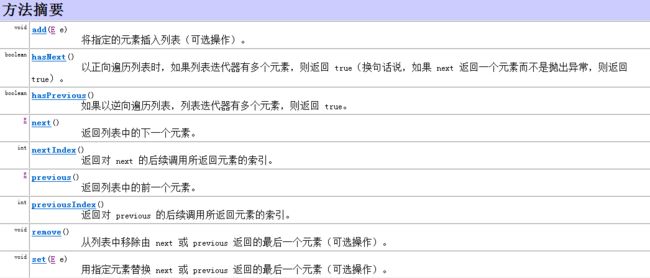一、迭代器概述
1、什么是迭代器?
在Java中,有很多的数据容器,对于这些的操作有很多的共性。Java采用了迭代器来为各种容器提供了公共的操作接口。这样使得对容器的遍历操作与其具体的底层实现相隔离,达到解耦的效果。
在Iterator接口中定义了三个方法:
2、迭代器使用
public static void main(String[] args) { Listlist=new ArrayList<>(); list.add("abc"); list.add("edf"); list.add("ghi"); for(Iterator it=list.iterator();it.hasNext();) { System.out.println(it.next()); } }
二、ArrayList的Iterator实现
private class Itr implements Iterator
{ int cursor; // index of next element to return int lastRet = -1; // index of last element returned; -1 if no such int expectedModCount = modCount; ... }
在ArrayList内部定义了一个内部类Itr,该类实现了Iterator接口。
在Itr中,有三个变量分别是
cursor:表示下一个元素的索引位置
lastRet:表示上一个元素的索引位置
expectModCount:预期被修改的次数
下面看一下Itr类实现了Iterator接口的三个方法:
public boolean hasNext() { return cursor != size;//当cursor不等于size时,表示仍有索引元素 }
public E next() //返回下一个元素 { checkForComodification(); int i = cursor; if (i >= size) throw new NoSuchElementException(); Object[] elementData = ArrayList.this.elementData; if (i >= elementData.length) throw new ConcurrentModificationException(); cursor = i + 1; return (E) elementData[lastRet = i]; }
在next()方法中有一个checkForComodification()方法,其实现为:
final void checkForComodification() { if (modCount != expectedModCount) throw new ConcurrentModificationException(); }
可以看到,该函数是用来判断集合的修改次数是否合法。
在集合内部维护一个字段modCount用于记录集合被修改的次数,每当集合内部结构发生变化(add,remove,set)时,modCount+1。
在迭代器内部也维护一个字段expectedModCount,同样记录当前集合修改的次数,初始化为集合的modCount值。当我们在调用Iterator进行遍历操作时,如果有其他线程修改list会出现modCount!=expectedModCount的情况,就会报并发修改异常java.util.ConcurrentModificationException。下面为示例代码:
public static void main(String[] args) { ArrayListaList=new ArrayList (); aList.add("bbc"); aList.add("abc"); aList.add("ysc"); aList.add("saa"); System.out.println("移除前:"+aList); Iterator it=aList.iterator(); while(it.hasNext()) { if("abc".equals(it.next())) { aList.remove("abc"); } } System.out.println("移除后:"+aList); }
上面的代码中,如果我们只使用迭代器来进行删除,则不会出现并发修改异常错误。
public static void main(String[] args) { ArrayListaList=new ArrayList (); aList.add("bbc"); aList.add("abc"); aList.add("ysc"); aList.add("saa"); System.out.println("移除前:"+aList); Iterator it=aList.iterator(); while(it.hasNext()) { if("abc".equals(it.next())) { it.remove(); } } System.out.println("移除后:"+aList); }
public void remove() { if (lastRet < 0) throw new IllegalStateException(); checkForComodification(); try { ArrayList.this.remove(lastRet); cursor = lastRet; lastRet = -1; expectedModCount = modCount; } catch (IndexOutOfBoundsException ex) { throw new ConcurrentModificationException(); } }
在执行remove操作时,同样先执行checkForComodification(),然后会执行ArrayList的remove()方法,该方法会将modCount值加1,这里我们将expectedModCount=modCount,使之保持统一。
三、ListIterator
上面可以看到,Iterator只提供了删除元素的方法remove,如果我们想要在遍历的时候添加元素怎么办?
ListIterator接口继承了Iterator接口,它允许程序员按照任一方向遍历列表,迭代期间修改列表,并获得迭代器在列表中的当前位置。
ListIterator接口定义了下面几个方法:
下面使用ListIterator来对list进行边遍历边添加元素操作:
public static void main(String[] args) { ArrayListaList = new ArrayList (); aList.add("bbc"); aList.add("abc"); aList.add("ysc"); aList.add("saa"); System.out.println("移除前:" + aList); ListIterator listIt = aList.listIterator(); while (listIt.hasNext()) { if ("abc".equals(listIt.next())) { listIt.add("haha"); } } System.out.println("移除后:" + aList); }





